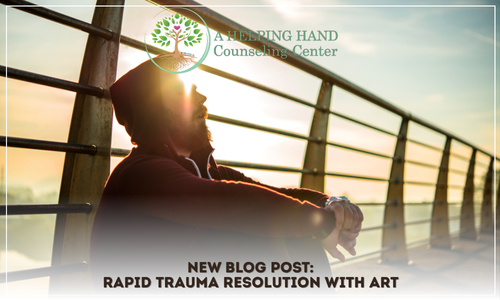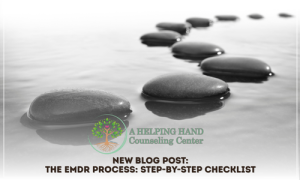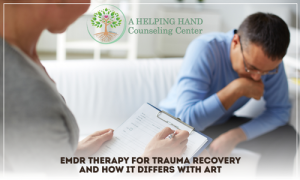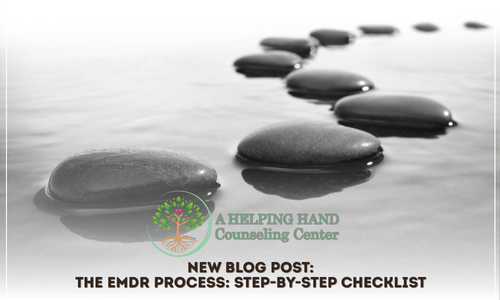
Rapid Trauma Resolution with ART
Rapid Trauma Resolution with ART Therapy: Benefits, Process, and Local Treatment in St. Cloud, FL
Accelerated Resolution Therapy (ART) is a brief, evidence-informed trauma therapy designed to speed up emotional healing by combining guided imagery with bilateral eye movements and memory rescripting. This article explains how ART works, which conditions it treats, and why many clients experience fast reductions in distress while avoiding prolonged verbal retelling of traumatic events. Readers will learn ART’s core mechanisms, practical session expectations, how ART compares to related therapies like EMDR, and what the current research landscape says about outcomes and limitations. We also map clinical applications for PTSD, anxiety, depression, phobias, and grief, and provide clear guidance for finding ART services locally in St. Cloud, Kissimmee, Narcoossee, and Osceola County. If you are considering ART for yourself or a family member (ages 5+), this guide offers an accessible, patient-centered overview and next steps for scheduling care.
What Is Accelerated Resolution Therapy and How Does It Work?
Accelerated Resolution Therapy (ART) is a brief trauma-focused approach that works by pairing bilateral stimulation—often eye movements—with guided imagery to help the brain reconsolidate distressing memories into less distressing forms. The mechanism pairs sensory-linked bilateral movement with imagery replacement so that the emotional charge of a memory is reduced while the factual content remains intact, resulting in rapid symptom relief for many clients. ART treats traumatic images, physical sensations, and intrusive memories by guiding the client to replace distressing images with new, adaptive imagery under therapist support. This method emphasizes client control, safety, and a non-verbal pathway to change, making it suitable for people who find detailed narration of trauma difficult or re-traumatizing.
Accelerated Resolution Therapy (ART): A Review and Research Update
Accelerated Resolution Therapy (ART) is a brief, evidence-informed trauma therapy designed to speed up emotional healing by combining guided imagery with bilateral eye movements and memory rescripting. This article explains how ART works, which conditions it treats, and why many clients experience fast reductions in distress while avoiding prolonged verbal retelling of traumatic events. Readers will learn ART’s core mechanisms, practical session expectations, how ART compares to related therapies like EMDR, and what the current research landscape says about outcomes and limitations. We also map clinical applications for PTSD, anxiety, depression, phobias, and grief, and provide clear guidance for finding ART services locally in St. Cloud, Kissimmee, Narcoossee, and Osceola County.
Accelerated resolution therapy (ART): a review and research to date, 2017
Who Developed ART and What Are Its Core Principles?
ART was developed by Laney Rosenzweig and is built on principles that prioritize rapid reprocessing, imagery replacement, and client safety during memory reconsolidation. The core therapeutic principles include using bilateral stimulation to facilitate neural processing, guiding clients to substitute positive or neutral imagery for painful mental images, and structuring sessions so clients can pause or redirect the process at any time. Therapists trained in ART emphasize informed consent and pacing to ensure clients remain grounded and in control throughout each session. These principles create an approach that balances physiological processing with compassionate clinical support.
How Do Eye Movements and Guided Imagery Facilitate Trauma Healing in ART?
Bilateral eye movements in ART are used to engage both hemispheres of the brain while the client holds a distressing image, creating conditions that promote reprocessing and memory reconsolidation. Guided imagery then helps the client intentionally replace the distressing image with a new, less upsetting or positive image, which alters the stored emotional response without erasing factual memory. This combination—movement plus imagery—supports a change in how the memory is encoded and experienced, often reducing physiological arousal and intrusive recall. In practice, clients report feeling less triggered by memories after a session, which illustrates how ART’s mechanisms translate into real-world symptom relief.
Which Conditions Can ART Therapy Effectively Treat?
ART is used across a range of trauma-related and anxiety-related conditions because it targets intrusive images and physiological responses that underlie many diagnoses. The approach is applicable to PTSD, generalized anxiety, depressive intrusive imagery, phobias, complicated grief, and other situations where distressing mental images maintain symptoms. ART’s adaptability means it can be used with adults, adolescents, and children (ages 5+) when delivered by trained clinicians, and it is often integrated into broader care plans alongside other supports. Below is a concise summary of common clinical targets and how ART typically applies.
- PTSD: Targets flashbacks, intrusive images, and hyperarousal. Often requires fewer sessions than long-term therapies. Evidence is emerging from controlled and clinical reports.
- Anxiety disorders: Addresses intrusive catastrophic images and avoidance. Involves a brief series targeting specific images. Supported by positive pilot data and case series.
- Depression (intrusive imagery): Focuses on negative imagery linked to mood. Utilizes focused imaginal rescripting across sessions. Preliminary supportive evidence exists.
- Phobias: Targets visualized triggers and physiological fear responses. Effective with targeted single-image work. Supported by clinical reports and small trials.
- Grief/Complicated loss: Reduces the distressing memories and images of the loss. Adapted rescripting helps reduce the pain of memories. Case series indicate benefit, with more research needed.
This list highlights ART’s clinical versatility across common trauma and stress-related conditions and shows where evidence is currently strongest and where more research is desirable. Understanding these condition-specific applications helps prospective clients and clinicians choose appropriate targets for ART work, especially for those seeking local treatment in St. Cloud, Kissimmee, and Osceola County.
How Does ART Address PTSD, Anxiety, and Depression?
ART addresses PTSD, anxiety, and depression by targeting the intrusive images, body sensations, and conditioned responses that maintain symptoms rather than relying primarily on verbal narrative. In PTSD, therapists guide clients to reprocess flashback imagery and reduce associated bodily distress so that triggers lose their intensity. For anxiety and depression with intrusive images, ART’s image substitution reduces the emotional power of those mental pictures and can break patterns of avoidance and rumination. Clinically, many clients report improved daily functioning and decreased symptom frequency within a few sessions, though individual results vary based on history and comorbidities.
ART for PTSD: A Systematic Review of Adult Treatment Efficacy
Accelerated Resolution Therapy (ART), developed in 2008, uses techniques such as rapid eye movement, in vivo exposure, and image rescripting to recondition stressful memories, and reduce physical and emotional reactions to traumatic memories. There is considerable interest in evidence-based treatments for post-traumatic stress disorder (PTSD). This is the first systematic review examining the efficacy of ART for the treatment of PTSD among adults.
Accelerated Resolution Therapy (ART) for the treatment of posttraumatic stress disorder in adults: A systematic review, JA Rash, 2008
Can ART Help with Phobias, Grief, and Emotional Healing?
ART’s imagery-based rescripting is adaptable to phobias, grief, and broader emotional healing by identifying the specific images or scenes that sustain fear or sorrow and facilitating a controlled replacement. For phobias, the therapist locates the most distressing mental image tied to the fear response and helps the client rapidly alter its emotional weight. In grief work, ART can reduce the painful intensity of memories that keep bereavement stuck, allowing people to access adaptive emotions and memories. Practitioners report that this flexibility enables ART to support a wide range of emotional healing needs in both adults and children seeking care in St. Cloud, FL, and surrounding areas.
What Are the Key Benefits of ART Therapy for Rapid Trauma Healing?
ART offers several client-centered advantages that make it a compelling choice for people seeking faster symptom relief without extensive verbal retelling. Key benefits include rapid reduction in distress, fewer sessions for many clients, minimal requirement to verbally recount traumatic events, and applicability across ages including children as young as five. ART’s focus on imagery replacement gives clients a tangible tool they can use to change how memories feel, and its structure emphasizes consent and control to reduce the risk of re-traumatization. Below, we compare ART on select attributes against typical expectations from other trauma therapies to show where ART commonly stands out.
- Speed of symptom relief: ART often offers a shorter course of treatment, with many clients reporting improvement in fewer sessions.
- Need for verbal recounting: There is minimal mandatory narrative; the imagery-focused process reduces the risk of re-traumatization.
- Number of sessions: Frequently fewer sessions are needed compared to long-term therapies.
- Applicability: Suitable for ages 5 and up, adaptable to in-person and secure telehealth formats, making it accessible for residents of St. Cloud, Kissimmee, Narcoossee, and Osceola County.
This comparison clarifies practical tradeoffs: ART tends to compress reprocessing into a shorter timeframe while preserving factual memory and emphasizing safety. For readers ready to pursue ART locally, A Helping Hand Counseling Center offers ART among its trauma treatment options and provides both in-person and secure telehealth sessions for clients in St. Cloud, Kissimmee, Narcoossee, and Osceola County. The center emphasizes compassionate, personalized care for individuals, couples, children, and families, and can help determine whether ART, EMDR, or another evidence-based approach best fits a client’s needs.
How Does ART Provide Rapid Relief Without Verbal Recounting of Trauma?
ART provides rapid relief by directly targeting the sensory and emotional components of distressing memories, allowing reprocessing to occur through bilateral stimulation and guided imagery rather than extended narrative exposure. This mechanism reduces the need for detailed, repeated verbal recounting, which can be triggering; instead, ART focuses on altering the memory’s emotional encoding while preserving factual recall. For clients who find talking about trauma intensely distressing, ART’s non-verbal pathway can make therapy more tolerable and effective. Clinically this often leads to quicker decreases in physiological reactivity and intrusive thoughts that previously disrupted functioning.
What Makes ART Different from Other Trauma Therapies Like EMDR?
ART and EMDR share the use of bilateral stimulation but differ in procedure, emphasis, and client experience: ART centers on guided imagery replacement and structured rescripting while EMDR follows an eight-phase protocol with more extensive cognitive processing. ART typically requires less narrative processing and often uses a more directive image substitution approach, which many clients experience as faster in reducing image-driven distress. EMDR has a comprehensive protocol useful across many trauma profiles, whereas ART’s streamlined imagery substitutions are particularly client-friendly for those who prefer minimal verbal retelling. For prospective clients in St. Cloud and surrounding areas, understanding these practical differences helps choose a therapy that aligns with comfort level and treatment goals.
ART Therapy Practice Comparisons and Client Transitions
This has created a broad network of ART therapists working facilitated continuation of ART treatment as clients transition
Practice comparisons between accelerated resolution therapy, eye movement desensitization and reprocessing and cognitive processing therapy with case examples, DF Hernandez, 2016
Is ART Therapy Evidence-Based? What Research Supports Its Effectiveness?
Current research on ART includes controlled trials, pilot studies, and clinical reports that indicate ART can reduce symptoms of PTSD and anxiety, though larger-scale randomized trials are still growing. Recent studies and clinical summaries report positive outcomes for many clients, including reductions in intrusive imagery and improved daily functioning after brief ART protocols. Therapists who use ART also describe meaningful functional gains among clients and highlight ART’s value as part of an individualized care plan that may include EMDR or other therapies when appropriate. Below is a concise research summary that captures study types and key findings in accessible terms for prospective clients.
- Controlled trials and pilot RCTs: For PTSD and trauma-exposed adults, positive reductions in symptom severity are reported; further large trials are recommended.
- Clinical case series: For mixed trauma, anxiety, and grief, consistent reports of rapid symptom improvement after targeted ART sessions are noted.
- Child and adolescent reports: Promising clinical outcomes for trauma-related distress in youth are observed; adaptation for younger clients shows feasibility.
This list reflects the current landscape: ART has accumulating supportive data and clinical endorsement, but like all therapies, it benefits from additional rigorous trials to clarify effect sizes and long-term durability. For those in St. Cloud, FL, seeking evidence-based trauma care, ART presents a promising option.
What Do Recent Studies Reveal About ART’s Success Rates for PTSD and Anxiety?
Recent studies vary in size and methods but generally indicate that ART can produce clinically meaningful reductions in PTSD and anxiety symptoms in a relatively brief treatment window. Pilot randomized and controlled studies show promising symptom declines and improved functioning for many participants, though sample sizes and follow-up durations differ across reports. Researchers commonly note the need for larger multi-site trials to confirm and extend current findings, and clinicians emphasize combining ART with good assessment and follow-up care for optimal outcomes. For potential clients in St. Cloud, Kissimmee, and Osceola County, this means ART is a credible option with growing empirical support but should be integrated into a personalized care plan.
How Do Expert Therapists Describe the Impact of ART on Clients?
Therapists who use ART frequently describe its impact in terms of rapid reduction in emotional reactivity, restored daily functioning, and improved coping with triggers that previously led to avoidance. Clinician reports emphasize that clients often notice less physiological arousal and fewer intrusive images after a short course of ART, which contributes to restored engagement in work, relationships, and daily activities. Experts also stress the importance of delivering ART within a framework of compassionate, personalized care that attends to safety, informed consent, and follow-up. Such professional perspectives align with ART’s client-centered design and underscore its potential value as part of a broader trauma treatment repertoire available to residents of St. Cloud, FL.
What Should You Expect During an ART Therapy Session?
An ART session begins with assessment and informed consent, moves through guided bilateral stimulation paired with imagery replacement, and ends with closure and stabilization strategies to ensure the client feels safe and able to manage between sessions. Sessions typically include a short intake to identify target memories, a processing phase where the therapist guides eye movements or other bilateral stimulation while the client works with imagery, and a closing phase that integrates new imagery and checks coping strategies. Client control is central: individuals can pause, stop, or redirect work at any time, and therapists use grounding techniques to maintain safety. Practical preparations are minimal, and clients should arrive ready to discuss goals while knowing they are not required to narrate traumatic details fully.
How Long Does a Typical ART Session Last and What Happens?
A typical ART session ranges from about 45 to 90 minutes depending on case complexity and client needs, with many sessions clustering toward a one-hour length for focused processing. Sessions generally follow phases: assessment/consent, targeted processing with bilateral stimulation and imagery replacement, and closure with stabilization and homework or coping strategies as needed. Telehealth sessions follow the same structure, with attention to camera positioning and privacy, while in-person work allows hands-on grounding if appropriate. Clients are advised to schedule sessions when they have support and time to rest afterward if intense emotions emerge, and therapists will provide guidance on aftercare.
How Is Client Control Maintained Throughout ART Therapy?
Client control in ART is maintained through explicit informed consent, pacing, and readily available grounding techniques that the client can use at any time to pause or exit the process. Therapists establish stop signals and teach breathing or grounding exercises prior to processing so clients can regulate distress during the session. The practitioner monitors physiological cues and checks in frequently to ensure the client feels empowered to direct the pace and intensity of work. This emphasis on consent and self-regulation reduces the risk of overwhelming the client and supports a sense of safety that facilitates effective memory reconsolidation.
Where Can You Find ART Therapy Services in St. Cloud, FL and Surrounding Areas?
Local access to ART in St. Cloud and nearby communities is increasingly available through clinics offering trauma-focused treatments and secure telehealth options for clients across Osceola County. When seeking ART services, consider providers who list ART and EMDR among their trauma specialties and who note experience working with diverse age groups including children (ages 5+). Telehealth expands access for clients in Kissimmee, Narcoossee, and surrounding neighborhoods, while in-person sessions are an option for those who prefer face-to-face contact. Below is a short list of pragmatic considerations to use when evaluating local ART providers in the St. Cloud, FL area.
- Check service formats: Confirm whether the clinic offers in-person sessions, secure telehealth, or both.
- Verify treatment focus: Look for providers who explicitly offer ART and EMDR for trauma and PTSD.
- Assess population served: Ensure the practice treats the relevant age group, including children if needed.
- Confirm intake process: Ask about how initial assessments and treatment planning are handled.
These considerations support informed decision-making and help you prepare for initial contact with a provider in St. Cloud, Kissimmee, or anywhere in Osceola County.
Why Choose A Helping Hand Counseling Center for ART in St. Cloud and Osceola County?
A Helping Hand Counseling Center provides ART and EMDR as part of a compassionate, personalized mental health offering for individuals, couples, children, and families across St. Cloud, Kissimmee, Narcoossee, and Osceola County. The center emphasizes local accessibility and secure telehealth options to meet clients where they are, and it serves a broad age range starting at five years old, which makes it suitable for families seeking trauma-focused care. AHHCC positions itself around trust and healing, offering targeted treatments for trauma, PTSD, anxiety, and emotional recovery while respecting client choice and safety. Prospective clients can inquire about suitability for ART versus other evidence-based options as part of an individualized care plan.
How Can You Schedule an ART Appointment and What Are the Telehealth Options?
To schedule ART at a local counseling center in St. Cloud, FL, begin by contacting a prospective provider to request an intake that covers presenting concerns, treatment history, and whether ART or EMDR is recommended; many clinics offer secure telehealth as a convenient option for working adults and families. Telehealth ART sessions follow the same clinical steps as in-person care with added attention to privacy, camera setup, and safety planning, allowing clients across Osceola County to access services without travel. A Helping Hand Counseling Center offers both in-person and secure telehealth appointments to accommodate different needs and has procedures to match clients with clinicians trained in ART and EMDR. If you are considering ART, reach out to discuss intake availability and whether this brief, imagery-focused approach fits your recovery goals.
- Next steps: Request an intake appointment and ask about clinician ART training and session formats.
- Telehealth note: Prepare a private space and reliable internet connection for remote sessions.
- What to bring: Think about 1–3 target memories or situations you wish to address to help guide the intake conversation.
Scheduling with a local provider in St. Cloud, Kissimmee, or Narcoossee is the practical step toward beginning ART and getting tailored guidance for your specific situation.
For compassionate, personalized ART and trauma care in St. Cloud, FL and surrounding areas, A Helping Hand Counseling Center offers trauma-focused services, including ART and EMDR, available in-person and via secure telehealth to clients across St. Cloud, Kissimmee, Narcoossee, and Osceola County. If you are ready to explore ART as a pathway to faster trauma resolution, contact a local provider today to arrange an intake and discuss whether ART is a fit for your goals and needs.
A Helping Hand Counseling Center
- 303 Commerce Center Drive St. Cloud, FL 34769
- teamcare@ahhcounseling.com
- (407) 450-5985
- www.ahhcounseling.com
Subscribe to Our Newsletter
Posts Category
Most Popular Posts

Accelerated Resolution Therapy (ART): Rapid Trauma Resolution Without Retelling the Pain
Accelerated Resolution Therapy (ART) is a trauma-focused treatment that helps people heal faster by using a combination of guided imagery, eye movements, and memory reconsolidation.

EMDR Therapy for Trauma: A Practical, Step-by-Step Guide to Healing
Trauma leaves a mark, even long after an event has passed. EMDR therapy (Eye Movement Desensitization and Reprocessing) is one of the most researched and

Healing Trauma Through EMDR Therapy: How the Brain Finds Its Way Back to Calm
Trauma doesn’t always look like what we see in movies.It can come from a car accident, a painful breakup, an illness, or years of quiet
Subscribe to Our Newsletter




